DOI: https://doi.org/10.1038/s41467-024-45702-4
PMID: https://pubmed.ncbi.nlm.nih.gov/38360821
تاريخ النشر: 2024-02-15
الكوبالت ثلاثي التكافؤ عالي الدوران في أكسيد الكوبالت الهيدروكسيدي لأكسدة المياه بكفاءة
تم القبول: 1 فبراير 2024
نُشر على الإنترنت: 15 فبراير 2024
الملخص
أكسيد هيدروكسيد الكوبالت
تحليل الكهروكيمياء يؤكد الاستقرار الملحوظ لـ CoOOH في حالة الدوران العالي.
النتائج
التوزيع الإلكتروني للحالة ذات الدوران المنخفض والحالة ذات الدوران العالي
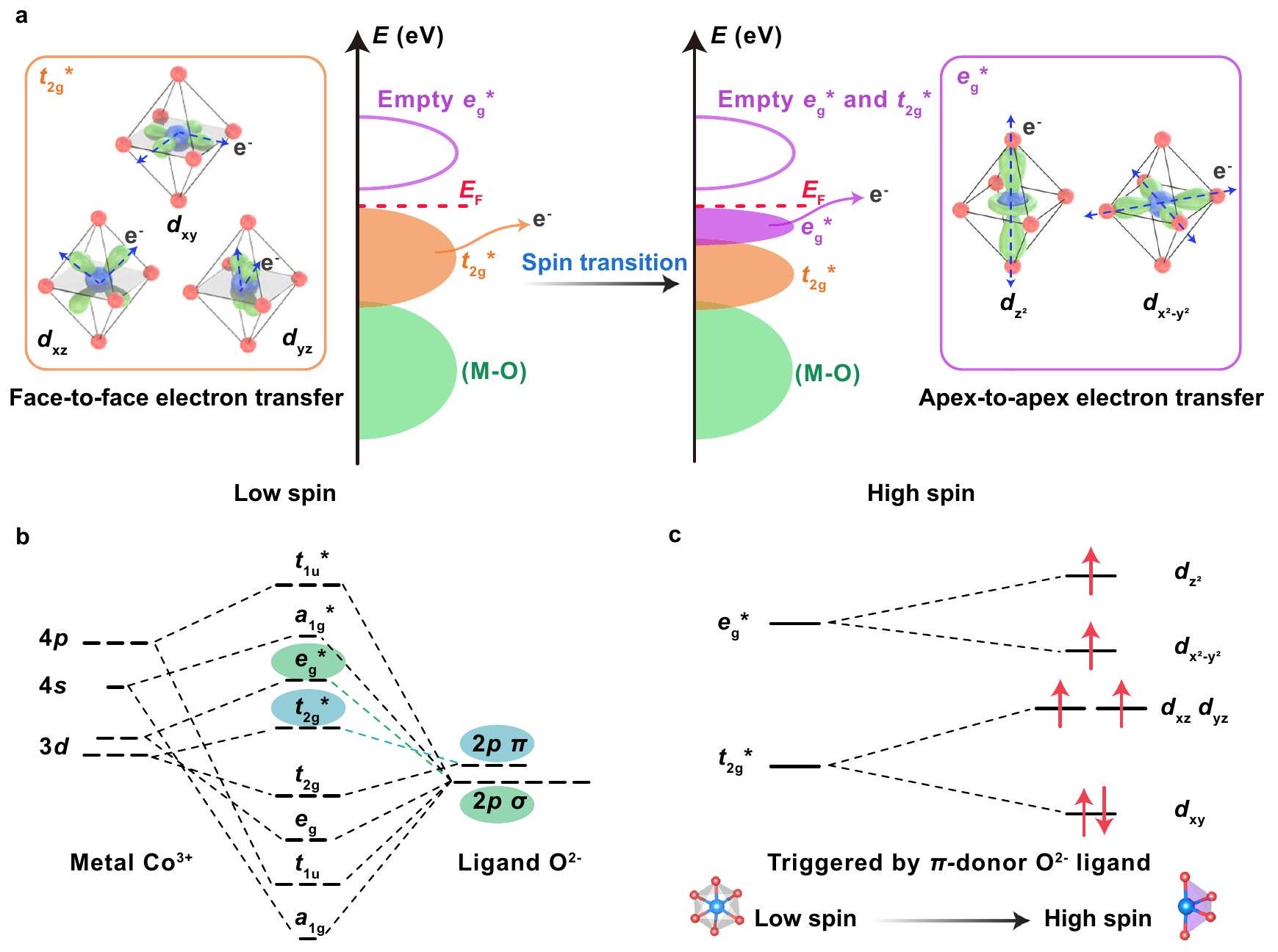
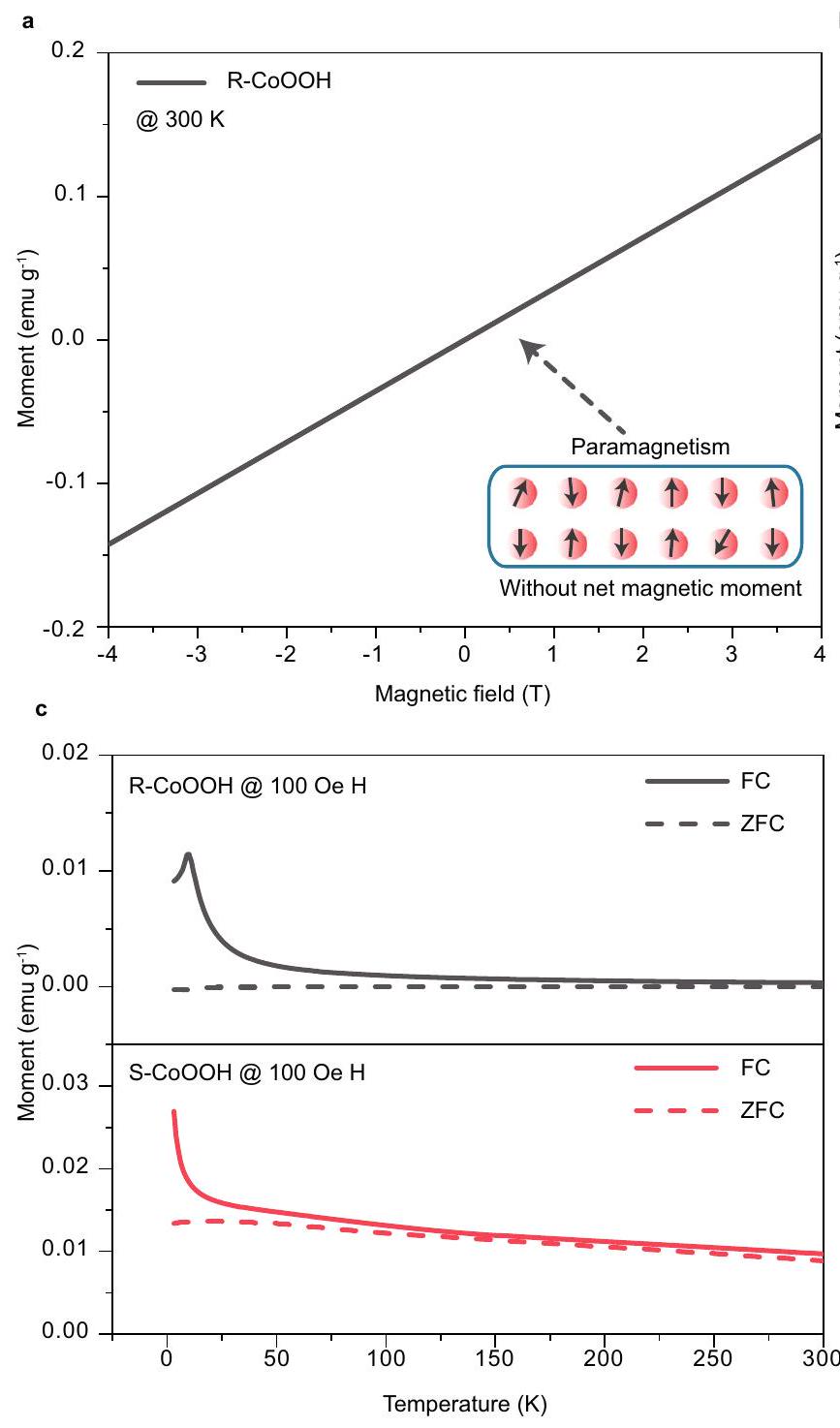

نشاط OER المحسن. ومع ذلك، لم يكن هناك دليل تجريبي يوضح تأثير حالة الدوران العالي.
توصيف الحالة ذات الدوران العالي
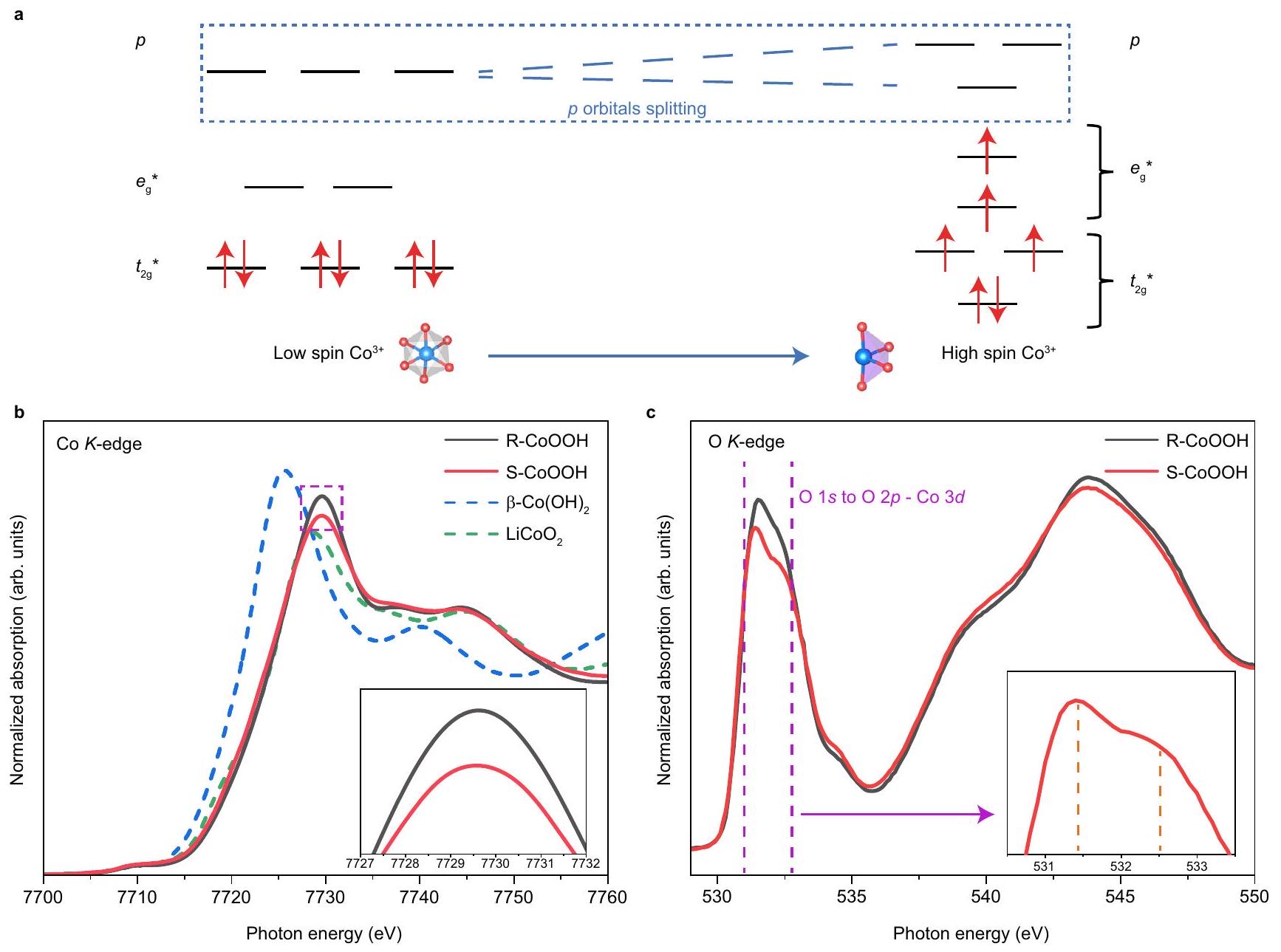
يتم تقليل المجال المغناطيسي الخارجي إلى الصفر (الشكل 2ب). تشير هذه الميزات إلى أن S-CoOOH يظهر سلوكًا فيرومغناطيسيًا عند 300 كلفن مع إلكترونات غير متزاوجة. يكشف التحليل الإضافي لمنحنيات المغنطة المعتمدة على درجة الحرارة (M-T) لـ R-CoOOH (الشكل 2ج) عن نقطة انحناء حول 10 كلفن، تُعرف باسم درجة حرارة نيل، مما يشير إلى انتقال من حالة بارامغناطيسية إلى حالة مضادة للمغناطيسية. بالنظر إلى أن 3 كلفن أقل من درجة حرارة نيل، فإن ذلك يؤكد السلوك المضاد للمغناطيسية لـ R-CoOOH عند 3 كلفن (الشكل التكميلي S6)، حيث تكون جميع الإلكترونات متزاوجة والإلكترونات القريبة في الحالة التكافؤية لها اتجاهات دوران معاكسة. الشخصية غير الخطية للمغناطيسية المضادة في
الخصائص في S-CoOOH (تم تقديم مناقشة مفصلة في الشكل التوضيحي S9).
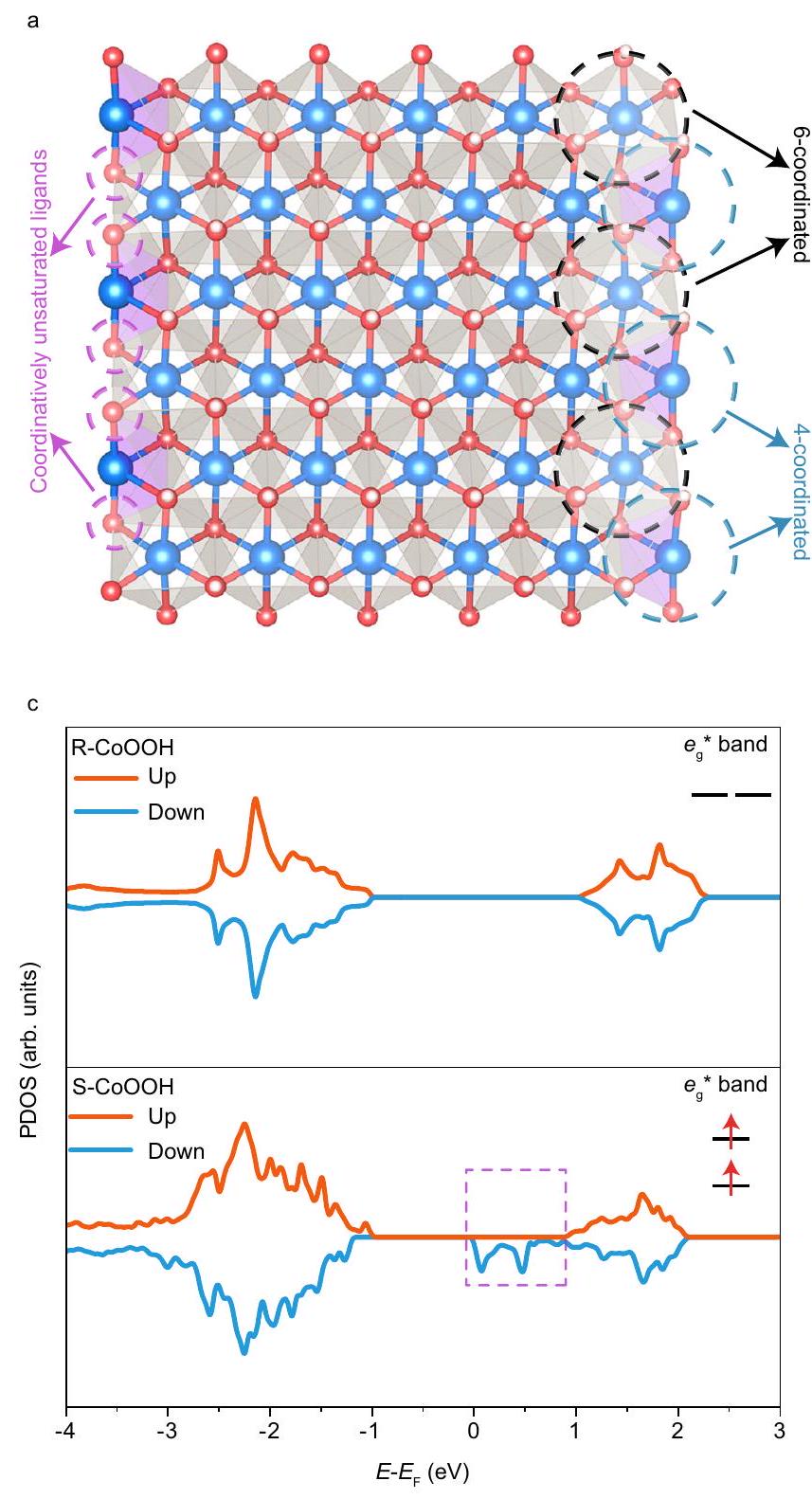


و الخط الأبيض مرتبط عمومًا بقفز الإلكترون من
استخدمت للتحقيق في
أصل حالة الدوران العالي
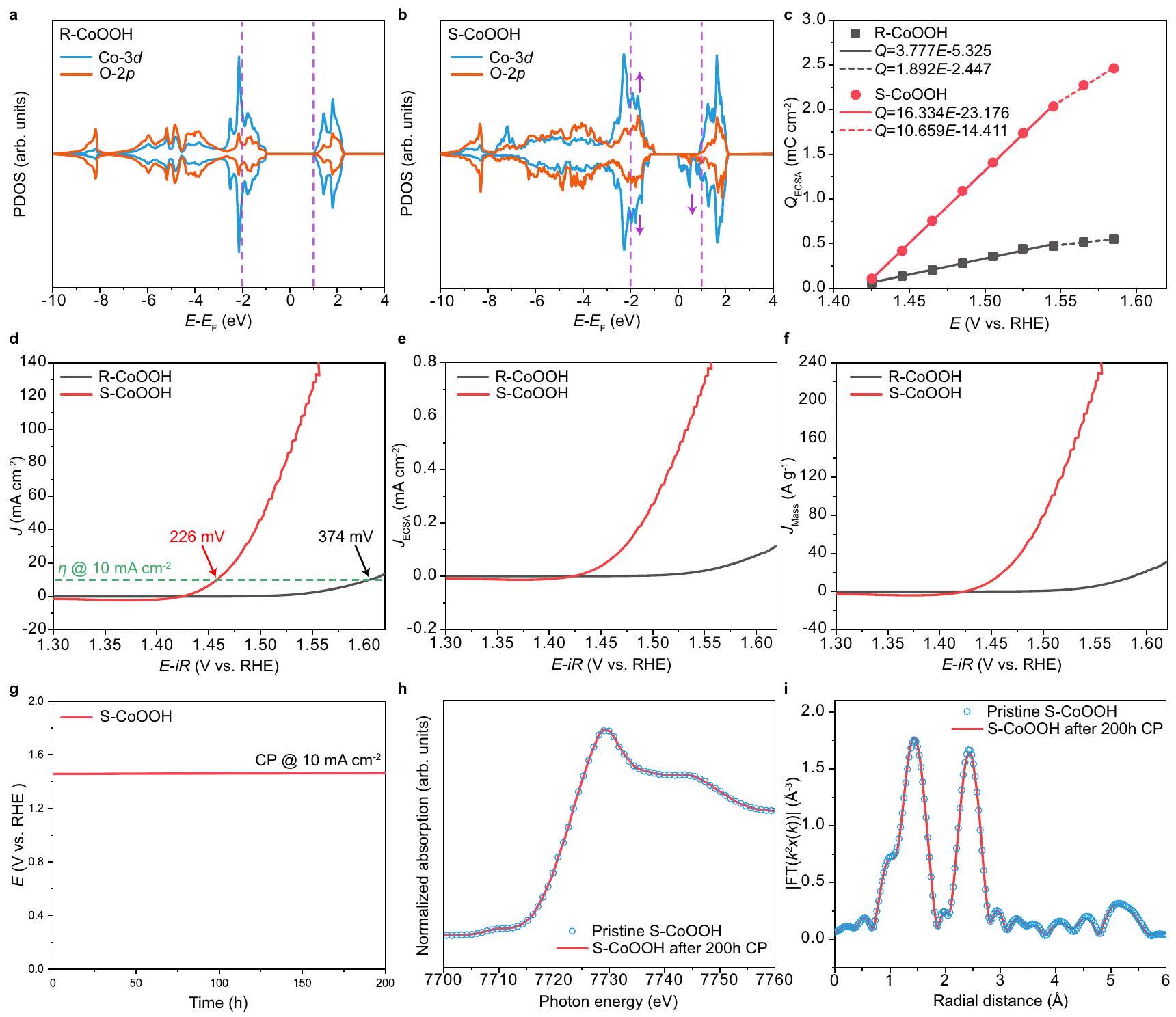
ذرات الكوبالت غير المشبعة في S-CoOOH، مما سيؤدي إلى تركيز أعلى من فراغات الأكسجين، بما يتماشى مع نتائج EPR (الشكل 2d). بالإضافة إلى ذلك، تُظهر صورة المجهر الإلكتروني الناقل الماسح (STEM) لـ S-CoOOH (الشكل التكميلي S14) كثافة من الهياكل النانوية الشبيهة بالإبر. النتيجة التجريبية المذكورة أعلاه مشابهة لهيكل الشريط النانوي الذي أبلغنا عنه سابقًا.
الفلزية. كما هو موضح في الشكل التكميلي S17، لوحظ انزياح أحمر صغير قدره 0.47 إلكترون فولت في طاقة الفوتون (مشار إليه بسهم بنفسجي) في S-CoOOH، مما يشير إلى حالة فلزية كوبالت أقل قليلاً من تلك الموجودة في R-CoOOH. يجب ملاحظة أن تغيير حالة الفلزية لكوبالت الناتج عن تغطية الهيدروجين وحالة الدوران يمكن أن ينظم
تأثير الحالة ذات الدوران العالي
الجهد الزائد لـ S-CoOOH المعدل على المساحة السطحية الكهروكيميائية (ECSA) هو أقل بكثير من ذلك لـ R-CoOOH (الشكل 5e). كما تظهر نتائج متسقة في النتائج من حيث كثافة التيار المعدلة على الكتلة المحملة (الشكل 5f). البيانات الكهروكيميائية الخام بدون
نقاش
طرق
المواد والمواد الكيميائية
تركيب S-CoOOH
تكوين الأقطاب الكهربائية، مع CC كقطب العمل وPt كقطب مضاد. كان المحلول الكهربائي يحتوي على 0.15 م.
تركيب R-CoOOH
إزالة شوائب الحديد
الخصائص الهيكلية
خصائص XAS
الطريقة: المربعات الصغرى
الفضاء: ر
نطاق K: 3-13 Å
نطاق R:
البرمجيات: أرتيميس
الهيكل الأولي: قياسي
كود حساب مسار التشتت النظري: FEFF6
وزن K أثناء ملاءمة EXAFS: 1، 2، 3
وزن K المستخدم في الرسم: 3
القياسات المغناطيسية
حسابات العزم المغناطيسي الفعال
قياسات OER الكهروتحفيزية
قياسات الفولتمترية ذات المسح الخطي (LSV)
رسوم بيانية على شكل لوحات
تعويض iR
تم تعيين التردد من 10 مللي هرتز إلى 100 كيلو هرتز. من قطر نصف الدائرة في مخططات نايكويست،
المساحة السطحية الكهروكيميائية (ECSA)
اختبارات الفولتمترية النبضية (PV)
الحسابات النظرية
توفر البيانات
References
- Wang, X. P. et al. Pivotal role of reversible
geometric conversion in oxygen evolution. Nature 611, 702-708 (2022). - Cho, H.-H. et al. A semiconducting polymer bulk heterojunction photoanode for solar water oxidation. Nat. Catal. 4, 431-438 (2021).
- Rao, R. R. et al. Operando identification of site-dependent water oxidation activity on ruthenium dioxide single-crystal surfaces. Nat. Catal. 3, 516-525 (2020).
- Zhang, B. et al. High-valence metals improve oxygen evolution reaction performance by modulating
metal oxidation cycle energetics. Nat. Catal. 3, 985-992 (2020). - Wang, X. P. et al. Understanding of oxygen redox in the oxygen evolution reaction. Adv. Mater. 34, 2107956 (2022).
- Zhong, H. Y. et al. Optimization of oxygen evolution activity by tuning
band broadening in nickel oxyhydroxide. Energy Environ. Sci. 16, 641-652 (2023). - Huang, J. H. et al. CoOOH nanosheets with high mass activity for water oxidation. Angew. Chem. 127, 8746-8851 (2015).
- Hausmann, J. N. et al. Understanding the formation of bulk- and surface-active layered (oxy)hydroxides for water oxidation starting from a cobalt selenite precursor. Energy Environ. Sci. 13, 3607-3619 (2020).
- Wu, C. et al. Origin of surface reconstruction in lattice oxygen oxidation mechanism based-transition metal oxides: a spontaneous chemical process. Angew. Chem. Int. Ed. 62, e202218599 (2023).
- Haase, F. T. et al. Size effects and active state formation of cobalt oxide nanoparticles during the oxygen evolution reaction. Nat. Energy 7, 765-773 (2022).
- Dou, Y. H. et al. Interpolation between W dopant and Co vacancy in CoOOH for enhanced oxygen evolution catalysis. Adv. Mater. 34, 2104667 (2022).
- Zhuang, L. Z. et al. Ultrathin iron-cobalt oxide nanosheets with abundant oxygen vacancies for the oxygen evolution reaction. Adv. Mater. 29, 1606793 (2017).
- Hu, J. et al. Improved interface charge transfer and redistribution in
p-n heterojunction nanoarray electrocatalyst for enhanced oxygen evolution reaction. Adv. Sci. 8, 2103314 (2021). - Chung, D. Y. et al. Dynamic stability of active sites in hydr(oxy) oxides for the oxygen evolution reaction. Nat. Energy 5, 222-230 (2020).
- Li, F. F. et al. An enhanced oxygen evolution reaction on 2 D CoOOH via strain engineering: an insightful view from spin state transition. J. Mater. Chem. A 9, 17749-17759 (2021).
- Zhou, S. M. et al. Engineering electrocatalytic activity in nanosized perovskite cobaltite through surface spin-state transition. Nat. Commun. 7, 11510 (2016).
- Zhang, Z. R. et al. Regulating spin states in oxygen electrocatalysis. Angew. Chem. Int. Ed. 62, e202216837 (2023).
- Wu, C. R. et al. Tuning the spin state of
by crystal facet engineering for enhancing the oxygen evolution reaction activity. Chem. Mater. 34, 10509-10516 (2022). - Sun, Y. M. et al. Engineering high-spin state cobalt cations in spinel zinc cobalt oxide for spin channel propagation and active site enhancement in water oxidation. Angew. Chem. Int. Ed. 60, 14536-14544 (2021).
- Zhong, H. Y. et al. Fundamental understanding of structural reconstruction behaviors in oxygen evolution reaction electrocatalysts. Adv. Energy Mater. 13, 2301391 (2023).
- Huang, Z.-F. et al. Chemical and structural origin of lattice oxygen oxidation in Co-Zn oxyhydroxide oxygen evolution electrocatalysts. Nat. Energy 4, 329-338 (2019).
- Wang, X. P. et al. Strain stabilized nickel hydroxide nanoribbons for efficient water splitting. Energy Environ. Sci. 13, 229-237 (2020).
- Newton, M. D. Comparison of electron-transfer matrix elements for transition-metal complexes:
vs. transfer and ammine vs. aqua ligands. J. Phys. Chem. 90, 3734-3739 (1986). - Khomskii, D. I. & Streltsov, S. V. Orbital effects in solids: basics, recent progress, and opportunities. Chem. Rev. 121, 2992-3030 (2021).
- Disa, A. S., Walker, F. J., Ismail-Beigi, S. & Ahn, C. H. Research update: orbital polarization in
-based heterostructures. APL Mater. 3, 062303 (2015). - Vogiatzis, K. D. et al. Computational approach to molecular catalysis by 3d transition metals: challenges and opportunities. Chem. Rev. 119, 2453-2523 (2019).
- Alvarez, S. & Cirera, J. How high the spin? allowed and forbidden spin states in transition-metal chemistry. Angew. Chem. Int. Ed. 45, 3012-3020 (2006).
- Bajdich, M. et al. Theoretical investigation of the activity of cobalt oxides for the electrochemical oxidation of water. J. Am. Chem. Soc. 135, 13521-13530 (2013).
- Chen, K. et al. Evidence of the anomalous fluctuating magnetic state by pressure-driven 4 f valence change in
. J. Phys. Chem. Lett. 14, 1000-1006 (2023). - Du, X.-J. et al. [
] cations directed perovskite-like polar metal formate frameworks , and Mg : microwave-assisted synthesis, structures, and properties. Inorg. Chem. 61, 2265-2271 (2022). - Lee, N. et al. Highly nonlinear magnetoelectric effect in buckledhoneycomb antiferromagnetic
. Sci. Rep. 10, 12362 (2020). - Varghese, M. et al. Room-temperature mixed spin state of
in double perovskites: combined NMR and EPR studies in a potential inorganic pigment. J. Phys. Chem. C. 126, 8450-8460 (2022). - Carvalho, R.P. D. et al. Electron paramagnetic resonance analysis of active bio-Pd-based electrodes for fuel cells. Adv. Mater. Res. 71-73, 737-740 (2009).
- Gu, M.-W. et al. Increased surface density of states at the Fermi level for electron transport across single-molecule junctions. Angew. Chem. Int. Ed. 62, e202214963 (2023).
- Nong, H. N. et al. Key role of chemistry versus bias in electrocatalytic oxygen evolution. Nature 587, 408-413 (2020).
- Mefford, J. T. et al. Correlative operando microscopy of oxygen evolution electrocatalysts. Nature 593, 67-73 (2021).
- Wang, S. H. et al. Identifying the geometric catalytic active sites of crystalline cobalt oxyhydroxides for oxygen evolution reaction. Nat. Commun. 13, 6650 (2022).
- Du, Y. H. et al. XAFCA: a new XAFS beamline for catalysis research. J. Synchrotron Radiat. 22, 839-843 (2015).
- Ravel, B. & Newville, M. ATHENA, ARTEMIS, HEPHAESTUS: data analysis for X-ray absorption spectroscopy using IFEFFIT. J. Synchrotron Radiat. 12, 537-541 (2005).
- McCrory, C. C. L., Jung, S., Peters, J. C. & Jaramillo, T. F. Benchmarking heterogeneous electrocatalysts for the oxygen evolution reaction. J. Am. Chem. Soc. 135, 16977-16987 (2013).
- Perdew, J. P., Burke, K. & Ernzerhof, M. Generalized gradient approximation made simple. Phys. Rev. Lett. 77, 3865-3868 (1996).
- Kresse, G. & Joubert, D. From ultrasoft pseudopotentials to the projector augmented-wave method. Phys. Rev. B 59, 1758-1775 (1999).
- Dudarev, S. L. et al. Electron-energy-loss spectra and the structural stability of nickel oxide: An LSDA1U study. Phys. Rev. B 57, 1505-1509 (1998).
- Grimme, S., Antony, J., Ehrlich, S. & Krieg, H. A consistent and accurate ab initio parametrization of density functional dispersion correction (DFT-D) for the 94 elements H-Pu. J. Chem. Phys. 132, 154104 (2010).
- Wang, V. et al. VASPKIT: A user-friendly interface facilitating highthroughput computing and analysis using VASP code. Comput. Phys. Commun. 267, 108033 (2021).
- Momma, K. & Izumi, F. VESTA 3 for three-dimensional visualization of crystal, volumetric and morphology data. J. Appl. Crystallogr. 44, 1272-1276 (2011).
شكر وتقدير
مساهمات المؤلفين
المصالح المتنافسة
معلومات إضافية
المواد التكميلية متاحة على
https://doi.org/10.1038/s41467-024-45702-4.
http://www.nature.com/reprints
© المؤلف(ون) 2024
- ¹قسم علوم المواد والهندسة، الجامعة الوطنية في سنغافورة، سنغافورة 117575، سنغافورة.
معهد الاستدامة للكيماويات والطاقة والبيئة (ISCE)، وكالة العلوم والتكنولوجيا والبحث (Aستار)، سنغافورة 627833، سنغافورة. كلية علوم المواد والهندسة، جامعة سيتشوان، تشنغدو 610065، الصين. مدرسة علوم المواد والهندسة، جامعة نانيانغ التكنولوجية، سنغافورة 639798، سنغافورة. مصادر ضوء سينكروترون سنغافورة (SSLS)، جامعة سنغافورة الوطنية، سنغافورة 117603، سنغافورة. معهد الحوسبة عالية الأداء (IHPC)، وكالة العلوم والتكنولوجيا والبحث (Aستار)، سنغافورة 138632، سنغافورة. المختبر الوطني الرئيسي للبناء الذكي والتشغيل والصيانة الصحية للهندسة تحت الأرض العميقة، جامعة سيتشوان، تشنغدو 610065، الصين. شركة تيفوسن لأشباه الموصلات وتكنولوجيا طاقة الهيدروجين (يونان) المحدودة، مقاطعة وينشان ذاتية الحكم للزhuang و المياو 663200، الصين. هؤلاء المؤلفون ساهموا بالتساوي: شين زانغ، هاويين زونغ. البريد الإلكتروني:Xi_shibo@isce2.a-star.edu.sg; msewxia@nus.edu.sg; msexuejm@nus.edu.sg
DOI: https://doi.org/10.1038/s41467-024-45702-4
PMID: https://pubmed.ncbi.nlm.nih.gov/38360821
Publication Date: 2024-02-15
High-spin
Accepted: 1 February 2024
Published online: 15 February 2024
Abstract
Cobalt oxyhydroxide
electrochemical analysis confirm the remarkable stability of the CoOOH with high-spin state
Results
Electronic configuration of low-spin and high-spin state



enhanced OER activity. However, there has been no experimental evidence showing the effect of high-spin state
Characterization of high-spin state

external magnetic field is reduced to zero (Fig. 2b). These features signify that S-CoOOH exhibits ferromagnetic behavior at 300 K with unpaired electrons. Further analysis of the temperature-dependent magnetization (M-T) curves for R-CoOOH (Fig. 2c) reveals an inflection point around 10 K , referred to as the Néel temperature, suggesting a transition from a paramagnetic to an antiferromagnetic state. Considering that 3 K is below the Néel temperature, it confirms antiferromagnetic behavior of R-CoOOH at 3 K (Supplementary Fig. S6), where all electrons are paired up and adjacent valence electrons have opposite spin directions. The non-linear antiferromagnetic character in the
properties in S-CoOOH(A detailed discussion is provided in Supplementary Fig. S9).



and the white line are generally related to the electron jumping from
utilized to investigate the
Origin of high-spin state

unsaturated Co atoms in S-CoOOH, which would lead to a higher concentration of oxygen vacancies, consistent with the EPR results (Fig. 2d). Additionally, the scanning transmission electron microscopy (STEM) image of S-CoOOH (Supplementary Fig. S14) shows a density of needle-like nano structures. The above experimental result is similar to our previously reported nanoribbon structure
valence. As displayed in Supplementary Fig. S17, a small red-shift of 0.47 eV in the photon energy (noted by a purple arrow) is observed in S-CoOOH, indicating a slightly lower Co valence state than that of R-CoOOH. It should be noticed that both Co valence state change induced by hydrogen coverage and spin state could regulate the
Influence of high-spin state
overpotential of S-CoOOH normalized to electrochemical surface area (ECSA), is much lower than that of R-CoOOH (Fig. 5e). Consistent results are also evidenced in the results in terms of current density normalized to loading mass (Fig. 5f). The raw electrochemical data without
Discussion
Methods
Materials and reagents
Synthesis of S-CoOOH
electrodes configuration, with CC as the working electrode and Pt as the counter electrode. The electrolyte contained 0.15 M
Synthesis of R-CoOOH
Removal of Fe impurity
Structural characterizations
XAS characterizations
Method: least-squares
Space: R
K range: 3-13 Å
R range:
Software: Artemis
Initial structure: standard
Theoretical scattering path calculation code: FEFF6
K weight during EXAFS fitting: 1,2,3
K weight used in plot: 3
Magnetic measurements
Effective magnetic moment calculations
Electrocatalytic OER measurements
Linear sweep voltammetry (LSV) measurements
Tafel plots
iR compensation
frequency set from 10 mHz to 100 kHz . From the diameter of the semicircle in the Nyquist plots,
Electrochemical surface area (ECSA)
Pulse-voltammetry (PV) Tests
Theoretical calculations
Data availability
References
- Wang, X. P. et al. Pivotal role of reversible
geometric conversion in oxygen evolution. Nature 611, 702-708 (2022). - Cho, H.-H. et al. A semiconducting polymer bulk heterojunction photoanode for solar water oxidation. Nat. Catal. 4, 431-438 (2021).
- Rao, R. R. et al. Operando identification of site-dependent water oxidation activity on ruthenium dioxide single-crystal surfaces. Nat. Catal. 3, 516-525 (2020).
- Zhang, B. et al. High-valence metals improve oxygen evolution reaction performance by modulating
metal oxidation cycle energetics. Nat. Catal. 3, 985-992 (2020). - Wang, X. P. et al. Understanding of oxygen redox in the oxygen evolution reaction. Adv. Mater. 34, 2107956 (2022).
- Zhong, H. Y. et al. Optimization of oxygen evolution activity by tuning
band broadening in nickel oxyhydroxide. Energy Environ. Sci. 16, 641-652 (2023). - Huang, J. H. et al. CoOOH nanosheets with high mass activity for water oxidation. Angew. Chem. 127, 8746-8851 (2015).
- Hausmann, J. N. et al. Understanding the formation of bulk- and surface-active layered (oxy)hydroxides for water oxidation starting from a cobalt selenite precursor. Energy Environ. Sci. 13, 3607-3619 (2020).
- Wu, C. et al. Origin of surface reconstruction in lattice oxygen oxidation mechanism based-transition metal oxides: a spontaneous chemical process. Angew. Chem. Int. Ed. 62, e202218599 (2023).
- Haase, F. T. et al. Size effects and active state formation of cobalt oxide nanoparticles during the oxygen evolution reaction. Nat. Energy 7, 765-773 (2022).
- Dou, Y. H. et al. Interpolation between W dopant and Co vacancy in CoOOH for enhanced oxygen evolution catalysis. Adv. Mater. 34, 2104667 (2022).
- Zhuang, L. Z. et al. Ultrathin iron-cobalt oxide nanosheets with abundant oxygen vacancies for the oxygen evolution reaction. Adv. Mater. 29, 1606793 (2017).
- Hu, J. et al. Improved interface charge transfer and redistribution in
p-n heterojunction nanoarray electrocatalyst for enhanced oxygen evolution reaction. Adv. Sci. 8, 2103314 (2021). - Chung, D. Y. et al. Dynamic stability of active sites in hydr(oxy) oxides for the oxygen evolution reaction. Nat. Energy 5, 222-230 (2020).
- Li, F. F. et al. An enhanced oxygen evolution reaction on 2 D CoOOH via strain engineering: an insightful view from spin state transition. J. Mater. Chem. A 9, 17749-17759 (2021).
- Zhou, S. M. et al. Engineering electrocatalytic activity in nanosized perovskite cobaltite through surface spin-state transition. Nat. Commun. 7, 11510 (2016).
- Zhang, Z. R. et al. Regulating spin states in oxygen electrocatalysis. Angew. Chem. Int. Ed. 62, e202216837 (2023).
- Wu, C. R. et al. Tuning the spin state of
by crystal facet engineering for enhancing the oxygen evolution reaction activity. Chem. Mater. 34, 10509-10516 (2022). - Sun, Y. M. et al. Engineering high-spin state cobalt cations in spinel zinc cobalt oxide for spin channel propagation and active site enhancement in water oxidation. Angew. Chem. Int. Ed. 60, 14536-14544 (2021).
- Zhong, H. Y. et al. Fundamental understanding of structural reconstruction behaviors in oxygen evolution reaction electrocatalysts. Adv. Energy Mater. 13, 2301391 (2023).
- Huang, Z.-F. et al. Chemical and structural origin of lattice oxygen oxidation in Co-Zn oxyhydroxide oxygen evolution electrocatalysts. Nat. Energy 4, 329-338 (2019).
- Wang, X. P. et al. Strain stabilized nickel hydroxide nanoribbons for efficient water splitting. Energy Environ. Sci. 13, 229-237 (2020).
- Newton, M. D. Comparison of electron-transfer matrix elements for transition-metal complexes:
vs. transfer and ammine vs. aqua ligands. J. Phys. Chem. 90, 3734-3739 (1986). - Khomskii, D. I. & Streltsov, S. V. Orbital effects in solids: basics, recent progress, and opportunities. Chem. Rev. 121, 2992-3030 (2021).
- Disa, A. S., Walker, F. J., Ismail-Beigi, S. & Ahn, C. H. Research update: orbital polarization in
-based heterostructures. APL Mater. 3, 062303 (2015). - Vogiatzis, K. D. et al. Computational approach to molecular catalysis by 3d transition metals: challenges and opportunities. Chem. Rev. 119, 2453-2523 (2019).
- Alvarez, S. & Cirera, J. How high the spin? allowed and forbidden spin states in transition-metal chemistry. Angew. Chem. Int. Ed. 45, 3012-3020 (2006).
- Bajdich, M. et al. Theoretical investigation of the activity of cobalt oxides for the electrochemical oxidation of water. J. Am. Chem. Soc. 135, 13521-13530 (2013).
- Chen, K. et al. Evidence of the anomalous fluctuating magnetic state by pressure-driven 4 f valence change in
. J. Phys. Chem. Lett. 14, 1000-1006 (2023). - Du, X.-J. et al. [
] cations directed perovskite-like polar metal formate frameworks , and Mg : microwave-assisted synthesis, structures, and properties. Inorg. Chem. 61, 2265-2271 (2022). - Lee, N. et al. Highly nonlinear magnetoelectric effect in buckledhoneycomb antiferromagnetic
. Sci. Rep. 10, 12362 (2020). - Varghese, M. et al. Room-temperature mixed spin state of
in double perovskites: combined NMR and EPR studies in a potential inorganic pigment. J. Phys. Chem. C. 126, 8450-8460 (2022). - Carvalho, R.P. D. et al. Electron paramagnetic resonance analysis of active bio-Pd-based electrodes for fuel cells. Adv. Mater. Res. 71-73, 737-740 (2009).
- Gu, M.-W. et al. Increased surface density of states at the Fermi level for electron transport across single-molecule junctions. Angew. Chem. Int. Ed. 62, e202214963 (2023).
- Nong, H. N. et al. Key role of chemistry versus bias in electrocatalytic oxygen evolution. Nature 587, 408-413 (2020).
- Mefford, J. T. et al. Correlative operando microscopy of oxygen evolution electrocatalysts. Nature 593, 67-73 (2021).
- Wang, S. H. et al. Identifying the geometric catalytic active sites of crystalline cobalt oxyhydroxides for oxygen evolution reaction. Nat. Commun. 13, 6650 (2022).
- Du, Y. H. et al. XAFCA: a new XAFS beamline for catalysis research. J. Synchrotron Radiat. 22, 839-843 (2015).
- Ravel, B. & Newville, M. ATHENA, ARTEMIS, HEPHAESTUS: data analysis for X-ray absorption spectroscopy using IFEFFIT. J. Synchrotron Radiat. 12, 537-541 (2005).
- McCrory, C. C. L., Jung, S., Peters, J. C. & Jaramillo, T. F. Benchmarking heterogeneous electrocatalysts for the oxygen evolution reaction. J. Am. Chem. Soc. 135, 16977-16987 (2013).
- Perdew, J. P., Burke, K. & Ernzerhof, M. Generalized gradient approximation made simple. Phys. Rev. Lett. 77, 3865-3868 (1996).
- Kresse, G. & Joubert, D. From ultrasoft pseudopotentials to the projector augmented-wave method. Phys. Rev. B 59, 1758-1775 (1999).
- Dudarev, S. L. et al. Electron-energy-loss spectra and the structural stability of nickel oxide: An LSDA1U study. Phys. Rev. B 57, 1505-1509 (1998).
- Grimme, S., Antony, J., Ehrlich, S. & Krieg, H. A consistent and accurate ab initio parametrization of density functional dispersion correction (DFT-D) for the 94 elements H-Pu. J. Chem. Phys. 132, 154104 (2010).
- Wang, V. et al. VASPKIT: A user-friendly interface facilitating highthroughput computing and analysis using VASP code. Comput. Phys. Commun. 267, 108033 (2021).
- Momma, K. & Izumi, F. VESTA 3 for three-dimensional visualization of crystal, volumetric and morphology data. J. Appl. Crystallogr. 44, 1272-1276 (2011).
Acknowledgements
Author contributions
Competing interests
Additional information
supplementary material available at
https://doi.org/10.1038/s41467-024-45702-4.
http://www.nature.com/reprints
© The Author(s) 2024
- ¹Department of Materials Science and Engineering, National University of Singapore, Singapore 117575, Singapore.
Institute of Sustainability for Chemical, Energy and Environment (ISCE), Agency for Science, Technology and Research (ASTAR), Singapore 627833, Singapore. College of Materials Science and Engineering, Sichuan University, Chengdu 610065, China. School of Materials Science and Engineering, Nanyang Technological University, Singapore 639798, Singapore. Singapore Synchrotron Light Sources (SSLS), National University of Singapore, Singapore 117603, Singapore. Institute of High Performance Computing (IHPC), Agency for Science, Technology and Research (ASTAR), Singapore 138632, Singapore. State Key Laboratory of Intelligent Construction and Healthy Operation and Maintenance of Deep Underground Engineering, Sichuan University, Chengdu 610065, China. Tefusen Semiconductor & Hydrogen Energy Technology (Yunnan) Co., Ltd, Wenshan Zhuang and Miao Autonomous Prefecture 663200, China. These authors contributed equally: Xin Zhang, Haoyin Zhong. e-mail: Xi_shibo@isce2.a-star.edu.sg; msewxia@nus.edu.sg; msexuejm@nus.edu.sg
